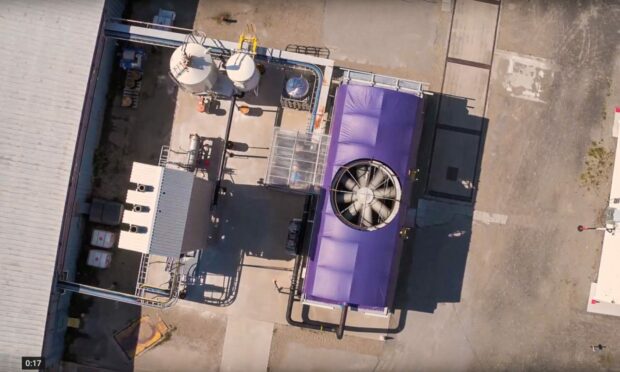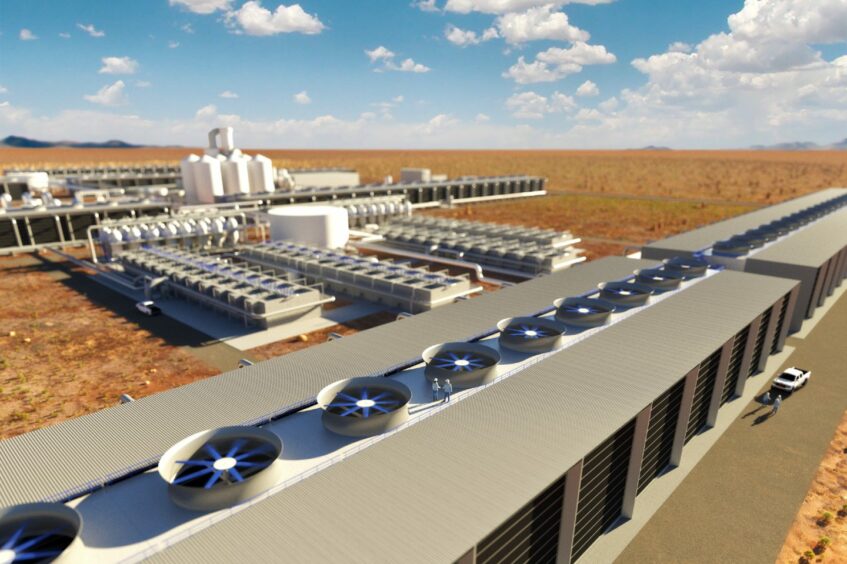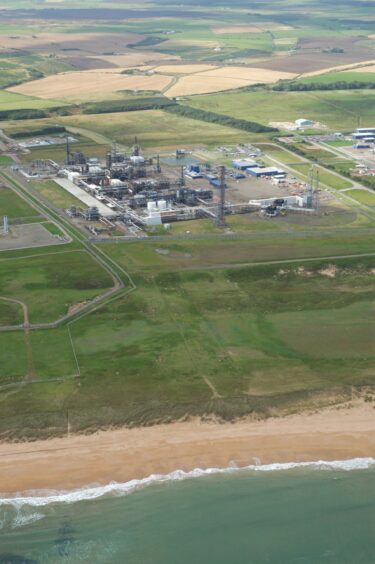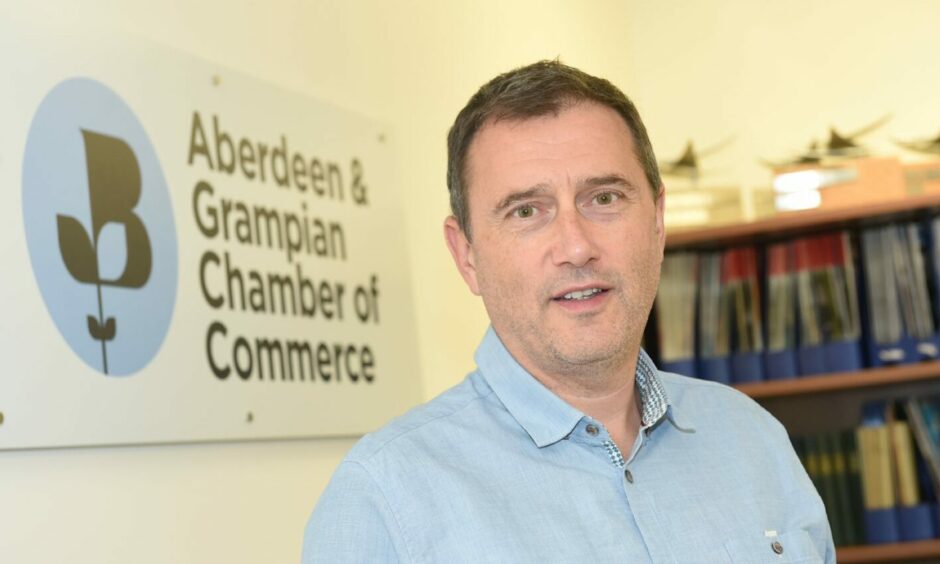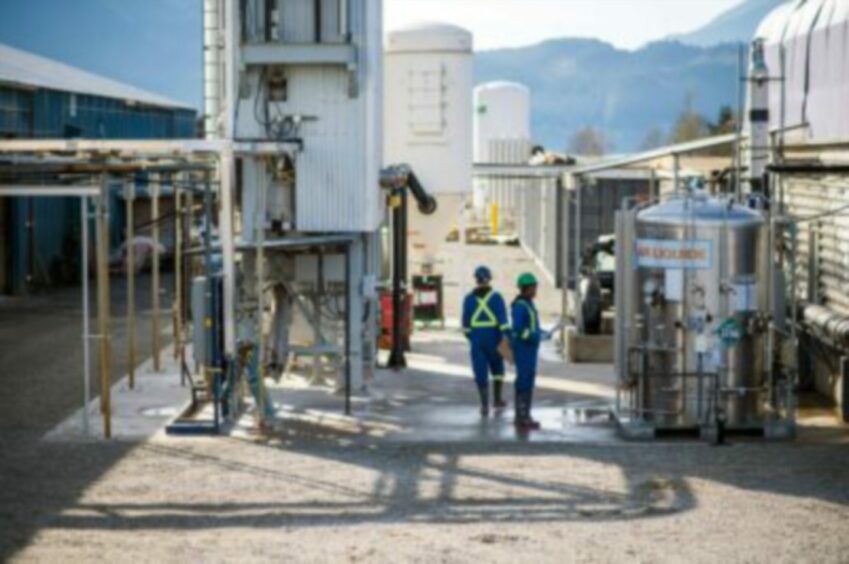Plans continue to move ahead for the north-east to be home to a facility using cutting-edge technology to capture massive amounts of carbon dioxide directly out of the atmosphere.
CO2 removed from the air will then be permanently stored in depleted offshore oil and gas fields in the North Sea.
The direct air capture (DAC) plant will be the first large-scale facility of its type in Europe, with the potential to extract up to one million tonnes of CO2 every year from the air.
It could be operational as early as 2026 and would be an important employer, especially in the construction phase.
Taking a leading position on direct air capture gives us the opportunity to develop our own decarbonisation industry, creating jobs along the supply chain and sharing these skills and knowledge with the world.”
Nick Cooper, CEO, Storegga.
The project is being developed by UK decarbonisation developer Storegga in partnership with Canada’s Carbon Engineering, which is pioneering commercial-scale DAC technology.
No exact north-east location has been announced to date, other than it will be built close to the Acorn CO2 transport and storage system.
The cost of the facility has also not been revealed yet, but it is likely to run into hundreds of millions of pounds.
The DAC plant is one part of a key decarbonisation initiative – the Scottish Cluster.
This has the goal of developing carbon capture and storage (CCS), hydrogen and other low-carbon technologies.
The Acorn project – developed in partnership by Storegga, Shell, Harbour Energy and North Sea Midstream Partners – at St Fergus, near Peterhead, will play a key role for the cluster, as Acorn will store captured CO2 deep underground in the North Sea.
The cluster, which could deliver more than 20,000 jobs, is led by the partners in Acorn and comprises a cross-sector group of Scottish industrial CO2 emitters.
Scotland’s energy sector was left dumfounded last October when the Scottish Cluster was not one of the CCS initiatives selected for UK Government funding. The two sites chosen were both south of the border.
Hopes rose of positive news for the Scottish Cluster in last month’s Spring Budget but nothing was forthcoming.
Storegga chief executive Nick Cooper said later the UK energy industry would be largely disappointed there had been no “rabbit out of the hat” from the chancellor for carbon capture and storage and hydrogen.
Mr Cooper added: “We have an opportunity to decarbonise the British energy industry, whilst also securing supply.
“But the Budget statement does not give us the broader decarbonisation roll-out we so desperately need.
“Successive governments of different flavours have failed to set out a long-term vision for the decarbonisation industry.
“The North Sea has been in decline for years, and is often seen as a dirty piece of our hydrocarbon-producing past we would rather forget.
“But the North Sea presents huge opportunity; an opportunity for a new industrial revolution, sucking up the smog of the past and generating clean energy.”
Investors kept waiting
Mr Cooper said investors from around the world were being held back by government procurement processes and slow progress on the necessary financial frameworks.
A spokesperson for Storegga told the Press and Journal: “We are continuing to work with the UK Government in good faith as the reserve cluster in the cluster-sequencing process, and doing all we can not to lose momentum behind the project.
“But, obviously, the longer we lack any clarity on the timelines to progress the cluster the more risk of delay to the delivery of the project.
“With commitment to support the cluster, development can progress. Every year and every month counts.”
What we now need is a timeline for this crucial part of our low-carbon future to be delivered.”
Russel Borthwick, CEO, Aberdeen and Grampian Chamber of Commerce.
The energy sector is hopeful the Scottish Cluster will be among several operating at scale in the UK by 2030.
Aberdeen and Grampian Chamber of Commerce chief executive Russell Borthwick said: “Businesses in the north-east are fully bought-in to the energy transition.
“What we now need is a timeline for this crucial part of our low-carbon future to be delivered.
“The Acorn project, with its established infrastructure and accelerated timeline for delivery, is one of the many reasons why Scotland was a standout location to be amongst the first UK clusters.”
Mr Borthwick added the UK Government had chosen a different direction, but he felt that now was an opportune moment to right that wrong and outline a clear timeline for delivering what would be a transformational project for Scotland.
There was one potentially positive development earlier this month when UK Energy Minister Greg Hands said further updates on CCS funding critical to the Acorn project would come later this year.
And there was good news recently when Storegga and Mitsui & Co, the Japanese trading and investment company, signed a memorandum of understanding on commercialising DAC.
North-east plant can be ‘model’
Mitsui is already an investor in Storegga and the memorandum marks a closer working relationship to realise the north-east plant.
Once developed, the site will provide a model for deploying this crucial carbon-reversal technology elsewhere in the UK and internationally to materially support global net-zero targets.
Storegga said the facility would be a vital component of meeting the UK and Scotland’s legally-binding net-zero targets by 2045 and 2050 respectively, and also have the ability to serve international customers.
Early customers of the facility will include Virgin Atlantic.
UK knowledge and tech ‘highly attractive’
Mr Cooper said: “The UK’s decarbonisation knowledge and technology are highly attractive to the world’s leading international infrastructure developers.
“Investor appetite is strong, but the path to decarbonisation is complex and will require the best minds from around the world, working together.
“The support of the UK Government is vital. Offshore wind has been a great success for the UK as a result of its supportive regulatory framework – the UK has the opportunity to repeat this early mover success with DAC.”
He added: “The international energy crisis has highlighted our need for enhanced self-reliance.
“Taking a leading position on direct air capture gives us the opportunity to develop our own decarbonisation industry, creating jobs along the supply chain and sharing these skills and knowledge with the world.
“Mitsui’s commitment says a lot about the quality of endeavour of the UK decarbonisation industry, and we look forward to working with the UK Government on a favourable regulatory regime that sets us up for future success.”
Sanjay Parekh, head of DAC at Storegga, said the technology was a meaningful way to truly and permanently offset carbon generation.
Mr Parekh added: “The recent Energy Transitions Commission report concluded direct air capture will be an essential component of cleaning up our atmosphere.
“We had a huge amount of interest in our business at COP26.
“The early-adopter companies who want to talk to us about buying direct air capture carbon credits are leading businesses around the world, with ambitious environmental, social and governance strategies.”
These businesses have a “genuine desire” to reduce emissions, avoid “flaky” offsetting and tangible plans to permanently remove CO2, he said, adding: “With the right support, direct air capture will not only reduce carbon in the coming years but could reverse the carbon damage done since the industrial revolution.”
Canadian firm’s air capture mission
The Canadian company playing an important role in the proposed direct air capture plant in Scotland was set up in 2009 with a clear mission – to develop and commercialise a technology that takes CO2 directly out of the atmosphere at megaton-scale.
Harvard professor David Keith and others had started to investigate direct air capture (DAC) as an additional tool to emissions reductions, due to a growing awareness the world would not only need to bring emissions to zero, but would also need to remove carbon from the atmosphere.
Breakthrough in 2015
With support from a team of academic scientists, business leaders and strategic investors, Prof Keith founded Carbon Engineering (CE) to take a promising concept into real-world, hardware-driven engineering and design.
Following years of prototyping and technology research and development, CE first captured CO2 from the air in 2015.
In partnership with 1PointFive, a development company formed by Oxy Low Carbon Ventures, CE is jointly engineering the first large-scale, commercial DAC facility.
Located in the Permian Basin in the US, this site is expected to capture one million tons of CO2 from the air annually when complete, to be permanently and safely stored deep underground in geological formations.
The trend is clear – leading markets have recognised the value that DAC and clean fuels can play in our efforts to get to net-zero and are working to incorporate them as fast as possible.”
In parallel with the Scottish partnership with Storegga, CE is progressing opportunities for further DAC and Air to Fuels plants in several markets around the world.
CE says recent years have seen major progress in the number of countries and markets implementing climate policy, and in the types of support for DAC and low-carbon fuels.
“DAC is viable in leading jurisdictions today,” the firm said, adding: “Policy-makers globally are seeking to replicate and expand successful policy frameworks, further strengthening the overall market.
“California’s Low Carbon Fuel Standard has established a strong precedent in its approach to DAC-to-sequestration projects.
“In California, DAC projects anywhere in the world that permanently store atmospheric CO2 underground can generate credits for the decarbonisation of California’s transportation sector.
“The trend is clear – leading markets have recognised the value that DAC and clean fuels can play in our efforts to get to net-zero and are working to incorporate them as fast as possible.
“As these leading policies, and more to follow, spread and tighten around the world, there is increasing potential for widespread global deployment of DAC.”
